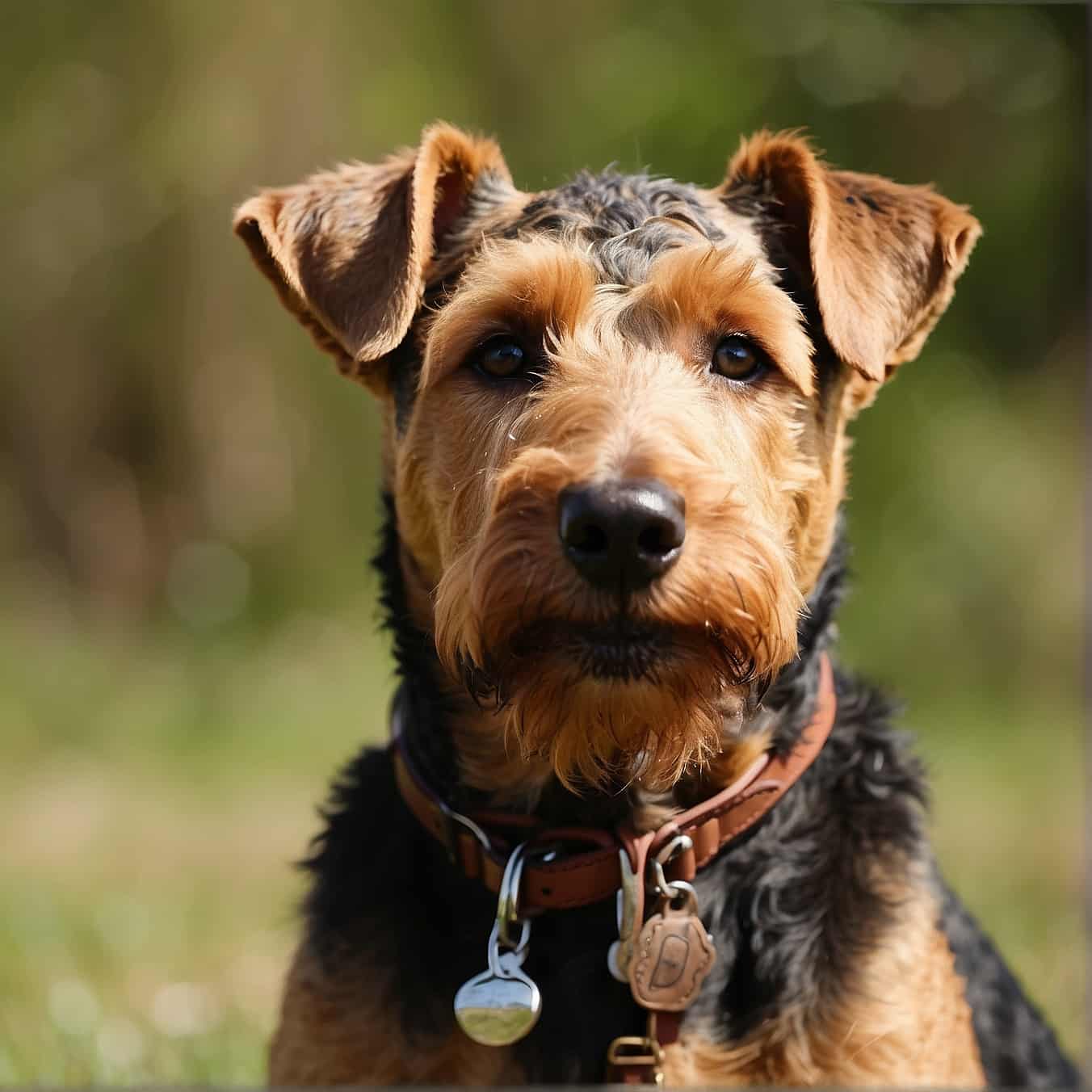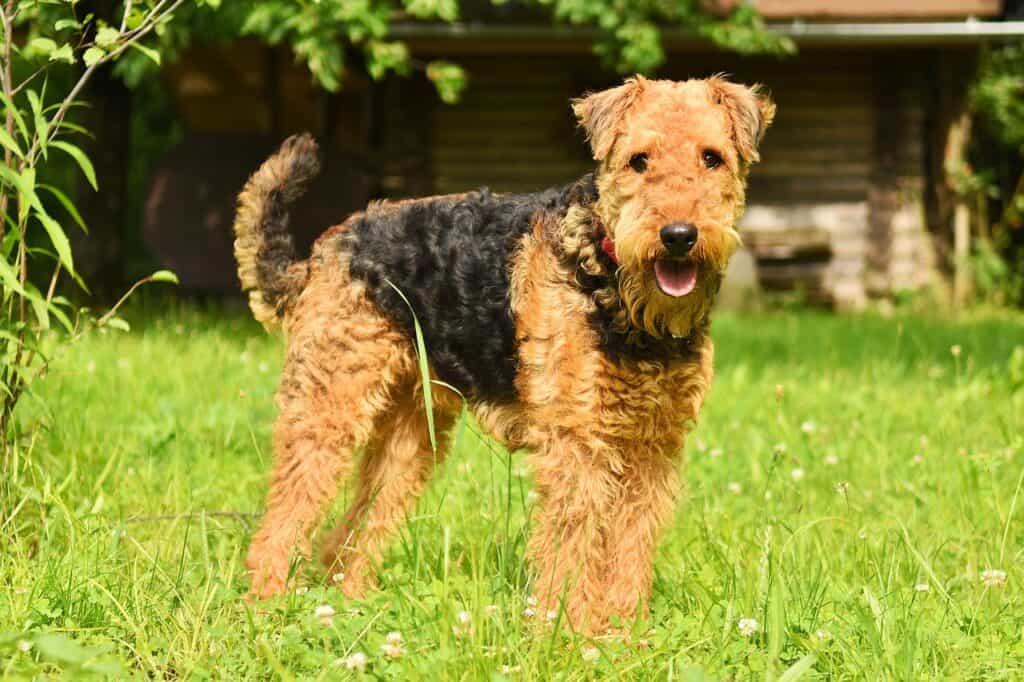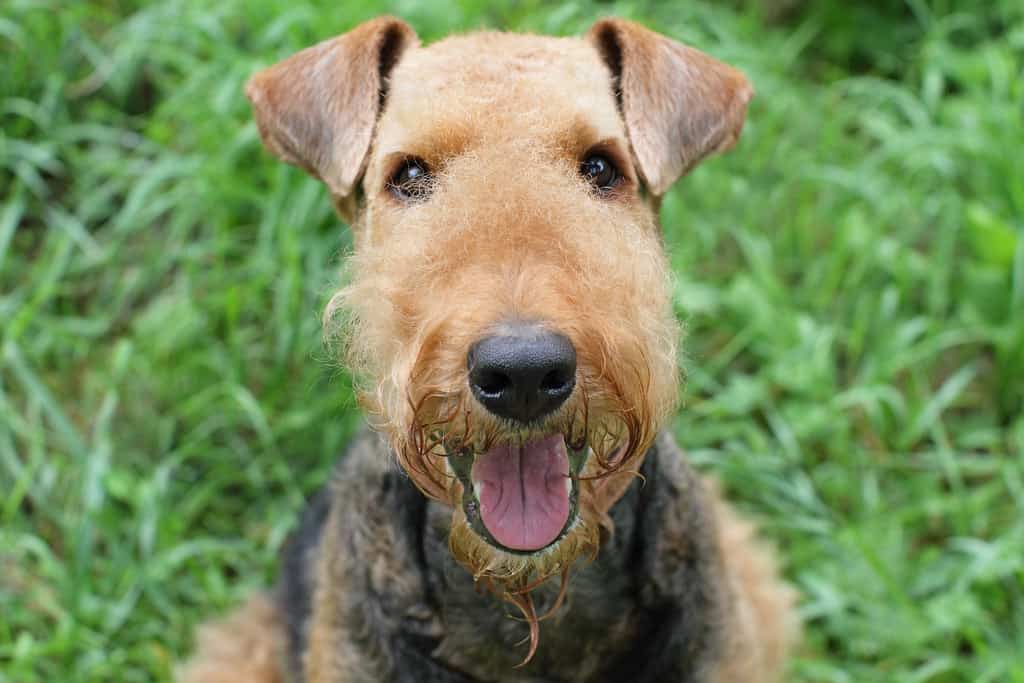The Airedale Terrier, often dubbed the King of Terriers, has a regal history and a robust character. Join us on a journey through their past, learn about their care needs, and explore the remarkable qualities that have made Airedales a favorite among terrier enthusiasts.

| Category (Explanation) | Breed Information |
|---|---|
| Year of Breed Conception | 1800s |
| Country of Origin | United Kingdom |
| Weight (lbs & kg) (Male) | 40-65 lbs (18-29.5 kg) |
| Weight (lbs & kg) (Female) | 35-55 lbs (16-25 kg) |
| Coat Type | Dense, wiry |
| Color Variations | Tan with a black saddle |
| Shedding Level (Low, Moderate, High) | Low to Moderate |
| Height (cm & in) | 21-23 inches (53-58 cm) |
| Breed Size | Large |
| Trainability (Low, Moderate, High) | High |
| Mental Needs (Low, Moderate, High) | Moderate |
| Intelligence Level (Low, Moderate, High) | High |
| Energy Level (Low, Moderate, High) | High |
| Agility (Low, Moderate, High) | High |
| Loyalty (Low, Moderate, High) | High |
| Playfulness (Low, Moderate, High) | Moderate |
| Exercise Needs | Regular exercise and mental stimulation |
| Guarding Proficiency (Low, Moderate, High) | Moderate |
| Sociability with Children (Low, Moderate, High) | High |
| Barking Level (Low, Moderate, High) | Moderate |
| Digging Tendency (Low, Moderate, High) | Moderate |
| Destructive Behavior (Low, Moderate, High) | Low |
| Drooling Level (Low, Moderate, High) | Low |
| Obedience Level (Low, Moderate, High) | Moderate |
| Apartment Friendly (Yes/No) | Can adapt to apartment living with sufficient exercise |
| Inherent Prey Drive | Moderate to High |
| Physical Risk to Others (Low, Moderate, High) | Low |
| Travel Fatality Risk (Low, Moderate, High) | Low |
| Allergen Potential | Low |
| Health Concerns (List of Common Health Concerns) | Hip Dysplasia, Skin Issues, Gastric Torsion |
| Average Life Expectancy (Life Expectancy in Years) | 10-13 years |
Woof Mastery is reader supported and our articles may contain affiliate links.
Instead of running third party ads that we have no control of we only use links from high-quality companies we are directly partnered with. Making use of these links come at no cost to you our reader, and in many cases have the extra benefit of discounted rates or sign up bonuses.
If you’re interested you can read more about our affiliate policy here.
We appreciate your support and always insure that the products and services we recommend are high-quality, helpful and relevant to the subject at hand!
The Airedale Terrier, often dubbed the King of Terriers, has a history that traces back to the rugged Yorkshire region in England. Bred to be versatile hunting dogs, they could work in water and on land. Their regal appearance and robust character made them stand out. Over time, Airedales transitioned from working dogs to beloved family pets. Their unwavering loyalty and courageous nature earned them a special place in the hearts of many. Today, Airedale Terriers are known for their distinctive appearance and the remarkable qualities that have made them a favorite among terrier enthusiasts.

The Airedale Terrier, often dubbed the King of Terriers, is special for its regal history and robust character. This breed brings a sense of majesty and loyalty to its owners. Explore their past, learn about their care needs, and appreciate their remarkable qualities. The Airedale Terrier’s unique position among terriers makes them special companions, beloved by enthusiasts worldwide.
The Airedale Terrier, often dubbed the King of Terriers, has a traditional role deeply rooted in their history as versatile working dogs. Originating in the Aire Valley of Yorkshire, England, Airedales were bred to excel in various roles. They were originally used as hunting dogs, capable of pursuing game of different sizes, including otters and rats. Their strength and courage made them invaluable for hunting and herding livestock. Additionally, they served as guardians of farms and homesteads, protecting families from wild predators. Over the years, their unwavering loyalty and tenacity earned them a reputation as reliable and fiercely protective working dogs. This enduring legacy of dependability and resilience continues today, as Airedales remain beloved family companions and capable working dogs, embodying the spirit of America’s frontier heritage.
Airedale Terriers, often referred to as the King of Terriers, have regal and robust personalities. They are known for their courageous and independent nature. These terriers are loyal and protective, making them excellent family pets. They require training and socialization to ensure their well-rounded personalities shine as loving and devoted companions.
Airedale Terriers have a regal and robust character. They are often courageous and loyal dogs. They can be protective of their families and may display territorial behavior if not properly managed through training and socialization. Their strength and size require careful control, particularly during leash training. They may not always get along with other dogs, especially of the same sex, necessitating careful introductions and supervision.
Airedale Terriers, often called the King of Terriers, are robust dogs with a wiry, dense, and straight coat that’s typically tan with a black saddle. They have a well-proportioned head with a flat skull, expressive dark eyes, and V-shaped ears that fold forward. Their neck is long and muscular, leading to a deep chest and straight legs. Airedales have a straight tail and a confident, agile gait. Their appearance exudes regal strength and resilience.
Airedale Terriers have a distinctive black and tan coat. Their saddle area, which extends from the back of the neck to the base of the tail, is typically black, while the rest of their body is tan. They may have a small white patch on their chest. This two-tone coloration highlights their noble and elegant appearance.
Airedale Terriers have a dense and wiry double coat that is typically tan with a black saddle. This saddle pattern is a notable characteristic of the breed.
Airedale Terriers have a low to moderate shedding level. They shed minimally throughout the year, and regular grooming can help manage loose hair. The breed’s wiry coat requires routine brushing to maintain its health and appearance. Airedales may experience increased shedding during seasonal changes, but overall, they are considered to be relatively low-shedding compared to some other breeds.
Airedale Terriers have a dense and wiry coat that requires regular grooming to maintain its quality. Grooming habits for Airedale Terriers include:
Airedale Terriers have a high activity level. As a terrier breed, they are energetic, playful, and enjoy various forms of exercise. Daily walks, playtime, and engaging activities are essential to keep them physically and mentally stimulated. Airedales thrive in environments where they can channel their energy through interactive play and outdoor adventures. Regular exercise is crucial to prevent boredom and potential behavioral issues.
Airedale Terriers are considered to be highly intelligent dogs. They are known for their problem-solving abilities, trainability, and versatility. Airedales excel in various activities, including obedience training, agility, and even as working dogs. Their intelligence is coupled with a confident and independent nature, making them quick learners and adaptable to different tasks and environments.
Airedale Terriers require mental stimulation to keep their intelligent minds engaged. Provide activities such as puzzle toys, obedience training, and interactive games to challenge them mentally.
Social Interaction: Airedales are social dogs and thrive on regular interaction with their human family members. Loneliness can lead to anxiety, so ensure they receive companionship and attention.
Exercise: Regular physical activity benefits not only their bodies but also their mental health. Adequate exercise helps reduce stress and anxiety in Airedale Terriers.
Training and Obedience: Airedales benefit from obedience training, providing mental stimulation and reinforcing their bond with owners. Positive-reinforcement training is effective in shaping their behavior.
Routine and Structure: Establishing a predictable daily routine helps Airedales feel secure and reduces anxiety. Dogs generally thrive on routine and structure.
Affection and Attention: Airedale Terriers, known for loyalty, need human companionship. Show affection and spend quality time with them to fulfill their need for attention.
Socialization: Early socialization is crucial for Airedales. Expose them to different people, animals, and environments to build confidence and ensure they become well-adjusted dogs.
Safe Environment: Create a safe and comfortable environment at home for Airedales to relax and feel secure. Provide a designated space for them to retreat to if they need alone time.
Consistency: Consistency in training and daily routines helps Airedales feel more secure and confident in their environment.
Enter The Woof Mastery

Before bringing an Airedale Terrier into your home, it’s important to understand their needs. These dogs are known for their intelligence and energy, requiring regular mental and physical stimulation. Training and socialization are crucial for their well-rounded behavior. Airedales thrive in an active family environment with ample opportunities for exercise and play. Prospective owners should be prepared for grooming needs and committed to providing the time and attention these loyal and spirited dogs deserve.
Airedale Terriers, known for their intelligence and loyalty, generally pose a low risk to others. Proper socialization and training are essential to ensure their friendly nature is well-directed. Individual temperament and upbringing play crucial roles in their behavior. Responsible ownership and adherence to local regulations contribute to a positive experience with this breed.
Airedale Terriers are known for being good with children. They are affectionate, playful, and often form strong bonds with the family. However, proper supervision is essential, especially with younger children, to ensure positive interactions and prevent unintentional rough play.
Airedale Terriers are generally good swimmers. Their love for water and strong build make them capable in the water. However, as with any dog, introduce them gradually to water and ensure their comfort. Always supervise them during swimming activities and be aware of their individual preferences.
Remember that Airedale Terrier puppies thrive on positive interactions and mental stimulation. Training should be a positive experience that builds a strong bond between you and your puppy.
Airedale Terriers are known for being relatively vocal. They may bark to alert their owners, express excitement, or communicate in various situations. Early training and socialization can help manage their barking tendencies and teach them appropriate times to vocalize.
Airedale Terriers are versatile and can adapt to various living conditions. They do well in homes with yards where they can play and explore. Regular exercise and mental stimulation are important for their well-being. Airedales can adapt to apartment living if provided with sufficient exercise, but a secure and fenced yard is ideal.
When traveling with Airedale Terriers, consider their size and energy level. They may require ample space in the vehicle and regular breaks for exercise. Ensure they are safely restrained, either in a secured crate or with a seatbelt harness. Monitor them for signs of anxiety or stress during travel and provide familiar items for comfort.
Airedale Terriers may be prone to certain health concerns. While individual dogs may not experience all of these issues, it’s essential for Airedale Terrier owners to be aware of potential health problems and collaborate with veterinarians to maintain their pets’ well-being. Common health concerns in Airedale Terriers include:
Regular veterinary check-ups, a balanced diet, proper exercise, and responsible breeding practices can help mitigate some of these health concerns. It’s crucial for Airedale Terrier owners to work closely with their veterinarians to monitor their pets’ health and address any issues promptly.
Proper nutrition is crucial for the health and well-being of Airedale Terriers. Here are some nutritional habits and best practices to consider for this breed:
Breed-Specific Laws (BSL): Airedale Terriers may be subject to breed-specific laws (BSL) in certain areas. These laws are often enacted at the local or municipal level and can vary widely from one jurisdiction to another.
Types of Restrictions: The specific restrictions imposed on Airedale Terriers under BSL can include mandatory spaying/neutering, special licensing, liability insurance requirements, muzzling in public, and, in some cases, bans on ownership. The severity of these restrictions depends on local regulations.
Rationale for BSL: BSL is typically implemented based on concerns about public safety and perceived risks associated with specific breeds, often due to incidents involving dog attacks. While Airedale Terriers are not inherently aggressive, they can be affected by BSL due to their physical resemblance to breeds that are sometimes included in these laws.
Controversy: It’s important to note that BSL is a controversial topic. Critics argue that it unfairly targets breeds rather than addressing individual dog behavior and that responsible ownership and training should be emphasized instead of breed-specific restrictions.
Local Regulations: To determine if there are breed-specific laws or restrictions regarding Airedale Terriers in your area, you should check with your local animal control or government authorities. Be aware of and comply with any local regulations to ensure that you are in compliance with the law while owning an Airedale Terrier.
Woof Mastery is reader supported and our articles may contain affiliate links.
Instead of running third party ads that we have no control of we only use links from high-quality companies we are directly partnered with. Making use of these links come at no cost to you our reader, and in many cases have the extra benefit of discounted rates or sign up bonuses.
If you’re interested you can read more about our affiliate policy here.
We appreciate your support and always insure that the products and services we recommend are high-quality, helpful and relevant to the subject at hand!
Myth 1: Airedales are aggressive.
Myth 2: They require extensive grooming.
Myth 3: Airedales are not good with children.
Myth 4: They are difficult to train.
Myth 5: They are high-strung and hyperactive.
Famous Airedale Terrier owners include:
The Airedale Terrier holds cultural significance in various contexts:
The Airedale Terrier, also known as the King of Terriers, gained popularity due to its versatility and intelligence. While there may not be a single most famous historical owner, Airedales have been favored by many, including President Warren G. Harding, who had an Airedale named Laddie Boy as a White House pet during his presidency.
Airedale Terriers, like many dog breeds, have encountered various challenges over the years. Some notable challenges include:
The Airedale Terrier is a breed that was developed in the 19th century in the Aire Valley of Yorkshire, England. It is believed to be a product of several terrier and hound breeds, including:
Airedale Terriers, known for their intelligence and versatility, embody the ideal family companion. Their origins as hunters and guardians have shaped them into loyal protectors. Their friendly and patient demeanor makes them excellent playmates for families with children. With minimal grooming requirements and adaptability to various living conditions, Airedale Terriers seamlessly integrate into diverse households.